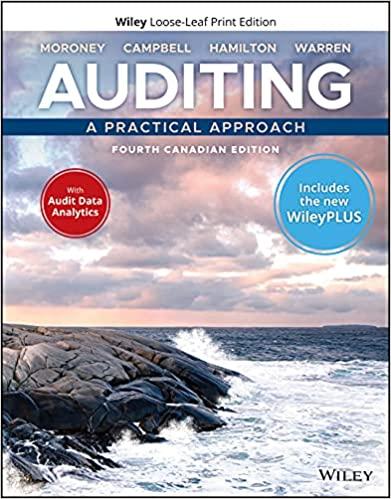Tinkerbell Toys Co. (Tinkerbell) is a manufacturer of childrens building block toys. It has been in business
Question:
Tinkerbell Toys Co. (Tinkerbell) is a manufacturer of children’s building block toys. It has been in business for more than 35 years and it sells to a wide variety of customers including large and small toy retailers across the country. The company’s year end is May 31.
The company has a large manufacturing plant, four large warehouses, and a head office. Upon manufacture, the toys are stored in one of the warehouses until they are shipped to customers. The company does not have an internal audit department.
Sales ordering, goods shipped, and invoicing Each customer has a unique customer account number and this is used to enter sales orders when they are received in writing from customers. The orders are entered by an order clerk and the system automatically checks that the goods are available and that the order will not take the customer over their credit limit. For new customers, a sales manager completes a credit application; this is checked through a credit agency and a credit limit is entered into the system by the credit controller. The company has a price list, which is updated twice a year. Larger customers are entitled to a discount; this is agreed to by the sales director and set up within the customer master file.
Once the order is entered, an acceptance is automatically sent to the customer by email confirming the goods ordered and a likely shipping date. The order is then sorted by customer address. The warehouse closest to the customer receives the order electronically and a shipping list and sequentially numbered goods shipped report (GSR) are automatically generated. The warehouse team packs the goods from the shipping list and, before they are sent out, a second member of the team double-checks the shipping list to the GSR, which accompanies the goods.
Once shipped, a copy of the GSR is sent to the accounting team at head office and a sequentially numbered sales invoice is raised and compared with the GSR. Periodically, a computer sequence check is performed for any missing sales invoice numbers.
Fraud During the year, a material fraud was uncovered. It involved cash/cheque receipts from customers being diverted into employees’ personal accounts. In order to cover up the fraud, receipts from subsequent unrelated customers were then recorded against the earlier outstanding receivable balances and this cycle of fraud would continue.
The fraud occurred because two members of staff who were related colluded. One processed cash receipts and prepared the weekly bank reconciliation; the other employee recorded customer receipts in the sales ledger. An unrelated sales ledger clerk was supposed to send out monthly customer statements but this was not performed. The bank reconciliations each had a small unreconciled amount but no one reviewed the reconciliations after they were prepared. The fraud was only uncovered when the two employees went on holiday at the same time and it was discovered that cash receipts from different customers were being applied to older receivable balances to hide the earlier sums stolen.
Required
a. Recommend six tests of controls the auditor would normally carry out on the sales system of Tinkerbell, and explain the objective for each test.
b. Describe substantive procedures the auditor should perform to confirm Tinkerbell’s year-end receivables balance.
c. Identify and explain controls Tinkerbell should implement to reduce the risk of fraud occurring again and, for each control, describe how it would mitigate the risk.
d. Describe substantive procedures the auditor should perform to confirm Tinkerbell’s revenue.
Step by Step Answer:

Auditing A Practical Approach
ISBN: 9781119709497
4th Canadian Edition
Authors: Robyn Moroney, Fiona Campbell, Jane Hamilton, Valerie Warren





